Multivariable Calculus Formulas, definitions properties and use cases
1/43
Earn XP
Description and Tags
Name | Mastery | Learn | Test | Matching | Spaced |
|---|
No study sessions yet.
44 Terms

ellipsoid
x²/a² + y²/b² + z²/c² =1
has a constant
a=b=c means it’s a sphere
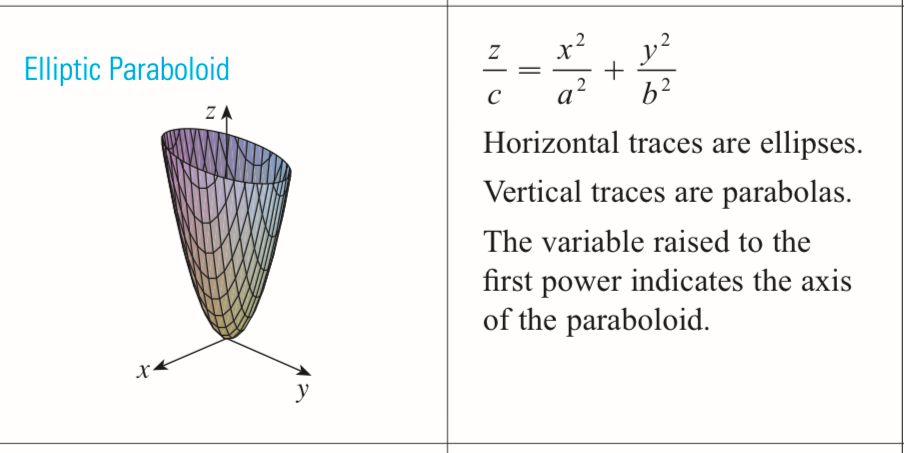
elliptic paraboloid
x²/a² + y²/b² = z/c
z/c is not squared
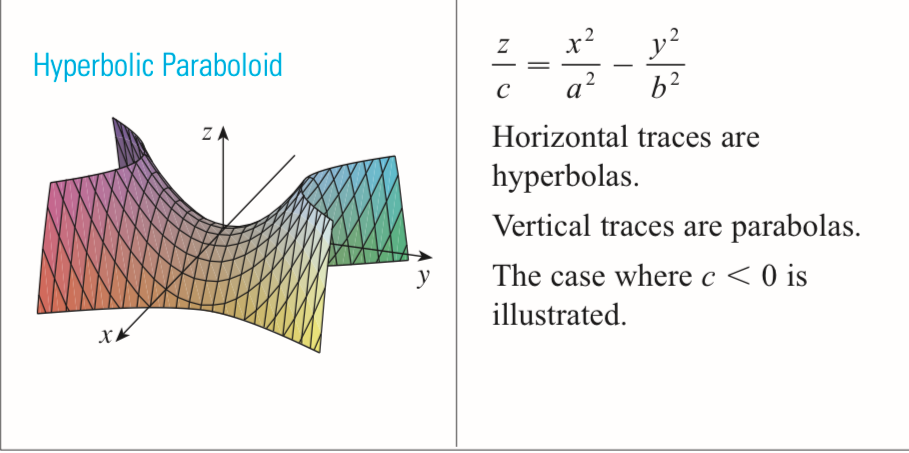
hyperbolic paraboloid
x²/a² - y²/b² = z/c
“hyper = negative”
z/c is not squared
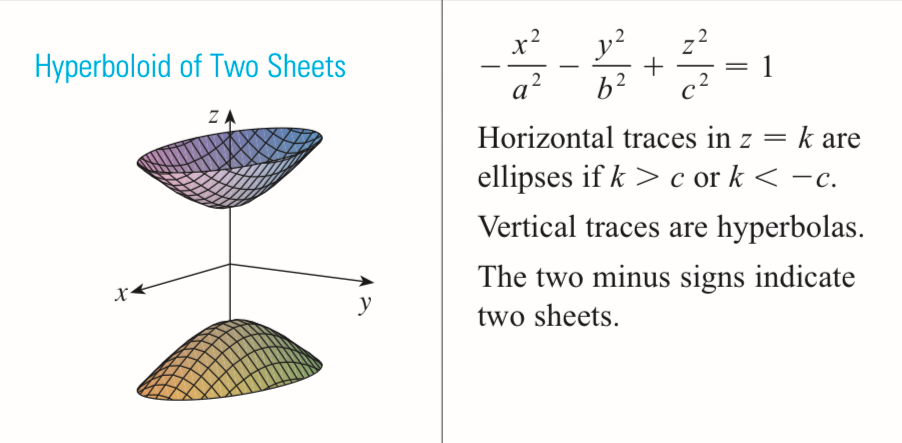
hyperboloid of two sheet
-x²/a² - y²/b² + z²/c² = 1
has a constant
always two negatives
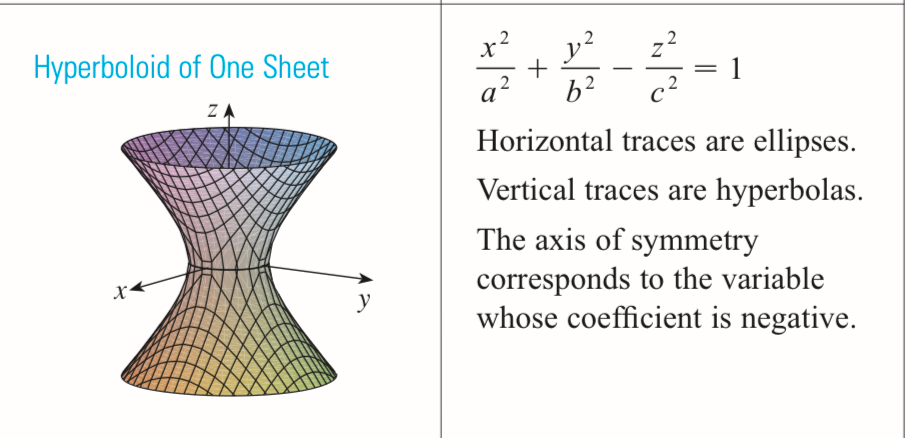
hyperboloid of one sheet
x²/a² + y²/b² - z²/c² = 1
has a constant
always one negative
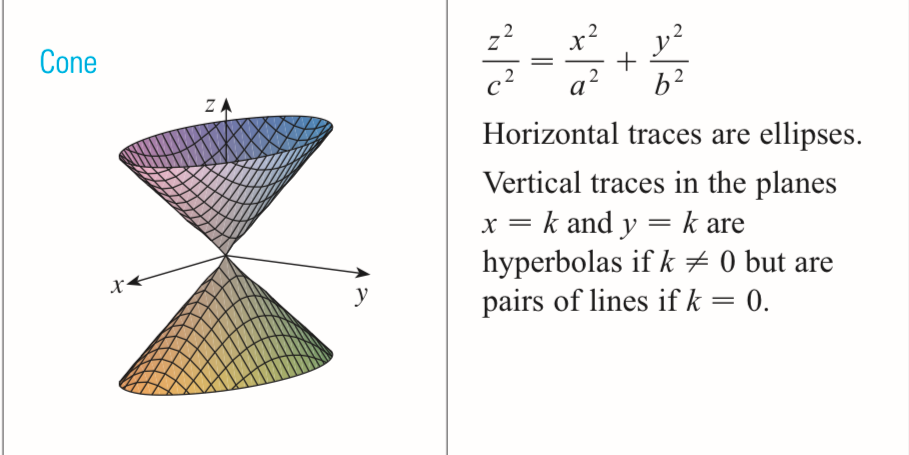
Cone
x²/a² - y²/b² = z²/c²
doesn’t have a constant
can be mistaken for hyperbolic paraboloid or hyperboloid
circular cylinder
x²-y²=1
only ever has two variables
parabolic cylinder
z=x²
only ever has two variables
| P1 P2 | =sqrt { (x2-x1)² + (y2 -y1)² +(z2-z1)² }
distance formula between two vectors
magnitude formula
|a|=sqrt(x² +y² +z²)
Vector direction
The letter that comes first, it’s the tail (initial point)
The letter that comes second, it’s the tip (terminal point)
all vectors but the zero vector have direction
Triangle law
AB(vector) +BC(vector) = AC(vector)
Scalar Multiple
C * vector
c stands for constant in this case
Scalar Multiple properties
c>0 same diction as vector
| c * vector| = c * |vector|
c<0 opposite direction of vector
| c * vector| = |c|* |vector|
c stands for constant in this case
Parallelogram Law
The parallelogram law states that the vector sum of two vectors is equal to the diagonal of the parallelogram formed by those two vectors. This means that if you place the tail of one vector at the head of the other vector, the diagonal of the resulting parallelogram represents the vector sum.
how find a vector from two points
P(1,2,3) and R(3,2,1)
Vector PR would be found by taking x, y and z values of R and minus the x, y and z values of P
PR=<2,0,-2>
adding vectors (triangle law in action)
a=< 5 ,- 12 > b=< -3 , -6 >
a+b = < (5 - 3) , (-12 -6) >=< 2 , -18 >
if the vectors have coefficients
2a+ 3b
first multiple the x,y,z values by the coefficients
2a=<10 ,-24 > and 3b=< -9 , -18 >
and then add them
To find a Unit vector that same given direction as the given vector
example v=8i-j+4k
find the magnitude
|v|=sqrt ( (8)² +(1)² +(4)²)= 9
then divide the vector by the magnitude
v/|v|= 8/9 i - 1/9 j + 4/9 k
Dot product Geometric Definition:
a⋅b=∣a∣∣b∣cos(θ)
Dot product Algebraic Definition:
a⋅b=axbx+ayby+azbz
Properties of dot product
a ⋅ a = |a|²
a ⋅ b = b ⋅ a
a ⋅ 0 = 0
a ⋅ (b+c) = a ⋅ b + a ⋅ c
Ka ⋅ b = K (a ⋅ b) = a ⋅ Kb
K= constant
a ⋅ b = 0
the vectors are perpendicular
Directional angle Cos α
ax/|a|
Directional angle Cos β
ay/|a|
Directional angle Cos γ
az/|a|
Cos² β +Cos² α + Cos² γ =1
property of Directional angles
If two vectors are parallel
they are scalar multiple of each other
To find actual directionals angles on a calculator
use inverse cos on the calculator
cross product
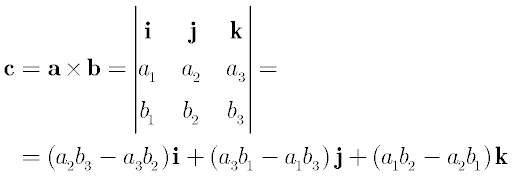
triple product
just replace i, j, k with the third vector
properties of the cross product
a x b = -b x a
a x (b + c) = a x b + a x c
Ka x b = K( a x b ) = a x (Kb)
a ⋅ (b x c) = ( a x b ) ⋅ c
a x b is perpendicular to a and b
Volume of parallelepiped determined by three vectors
V= | a ⋅ |b x c||
the bars mean absolute value
area of parallelepiped
|a x b|
area of a triangle
|a x b| / 2
the bars mean magnitude
parametric equation of line
through point p0(x0,y0,z0) and parallel to vector <a,b,c>
x=x0+a t y=y0 + b t z=z0 + c t
Symmetric equation of a line
x-x0/a = y-y0/b = z-z0/c
if a,b or c = 0, x=x0 , y-y0/b = z-z0/c
Plane equation
n ⋅ ( r1 -r0) =0
let n=<a,b,c> , r0=<x0,y0,z0> and r= <x,y,z> any point of the plane
a(x-x0)+b(y-y0)+c(z-z0)=0
ax+by+cz - (ax0+by0+cz0)=0
ax+by+cz+d=0
distance formula between planes and points and other planes
D= |n ⋅ b| / |n|